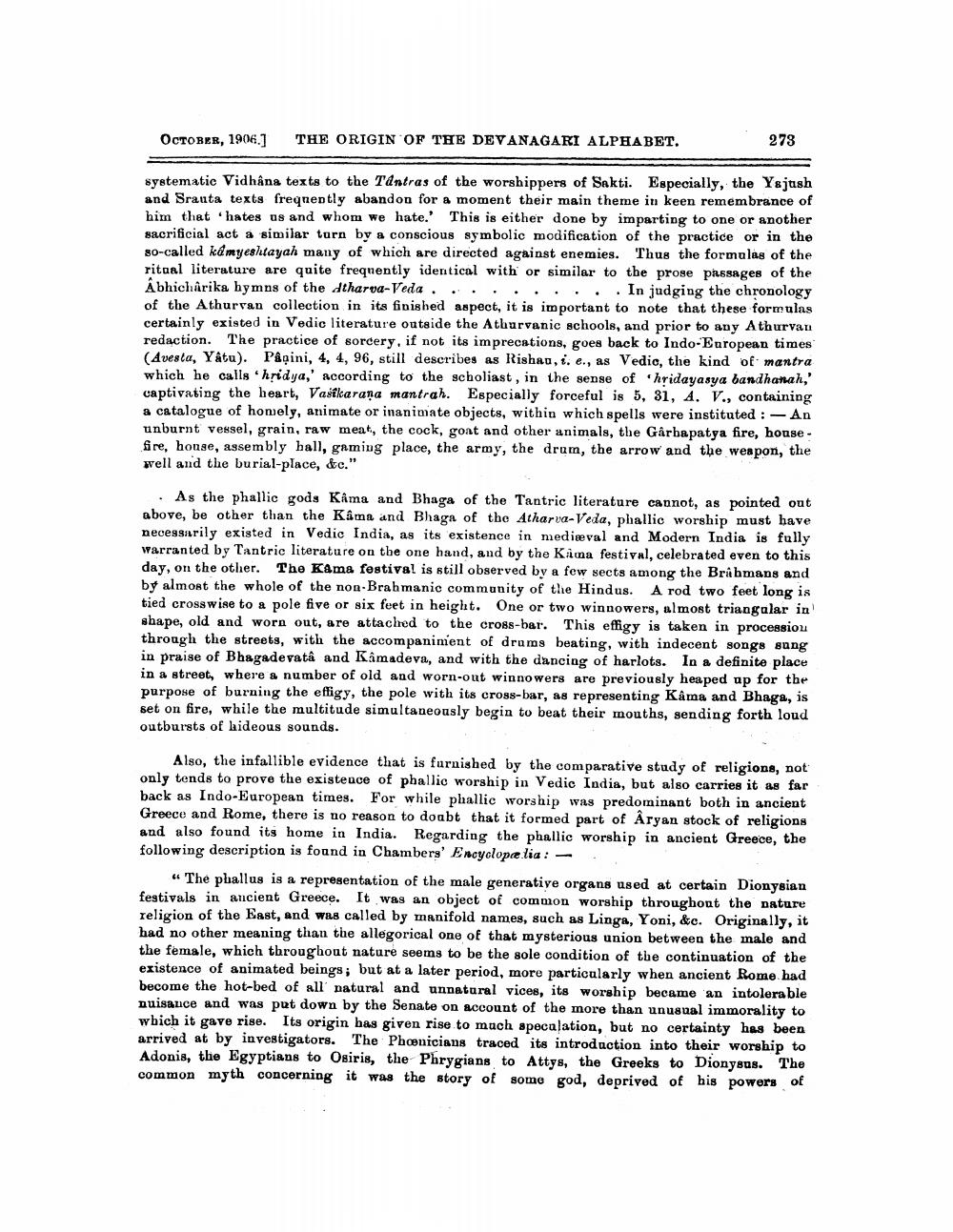________________
OCTOBER, 1906.]
THE ORIGIN OF THE DEVANAGARI ALPHABET.
273
systematic Vidhana texts to the Tantras of the worshippers of Sakti. Especially, the Yajtish and Srauta texts freqnently abandon for a moment their main theme in keen remembrance of him that hates us and whom we hate. This is either done by imparting to one or another sacrificial act a similar turn by a conscious symbolic modification of the practice or in the 80-called ka myeshtayah many of which are directed against enemies. Thus the formulas of the ritual literature are quite frequently identical with or similar to the prose passages of the Abhichirika hymns of the dtharva-Veda ......... In judging the chronology of the Athurvan collection in its finished aspect, it is important to note that these formulas certainly existed in Vedic literature outside the Atharvanic schools, and prior to any Athurvan redaction. The practice of sorcery, if not its imprecations, goes back to Indo-European times (Avesta, Yata). Pâqini, 4, 4, 96, still describes as Rishau, i. e., as Vedio, the kind of mantra which he calls hridya,' according to the scholiast, in the sense of hridayasya bandhanah,' captivating the heart, Vasikarana mantrah. Especially forceful is 5, 31, A. V., containing a catalogue of homoly, animate or inanimate objects, within which spells were instituted :- An unburnt vessel, grain, raw meat, the cock, goat and other animals, the Gârbapatya fire, house fire, house, assembly hall, gaming place, the army, the dram, the arrow and the weapon, the well and the burial-place, &c."
• As the phallic gods Kama and Bhaga of the Tantric literature cannot, as pointed out above, be other than the Käma and Bhaga of the Atharva-Veda, phallic worship must have necessarily existed in Vedic India, as its existence in medieval and Modern India is fully warranted by Tantric literature on the one hand, and by the Kina festival, celebrated even to this day, on the other. The Kama festival is still observed by a few sects among the Brahmans and by almost the whole of the non-Brahmanic community of the Hindus. A rod two feet long is tied crosswise to a pole five or six feet in height. One or two winnowers, almost triangular in shape, old and worn out, are attached to the cross-bar. This effigy is taken in processiou through the streets, with the accompaniment of drums beating, with indecent songs sung in praise of Bhagadevata and Kamadeva, and with the dancing of harlots. In a definite place in a street, where a number of old and worn-out winnowers are previously heaped up for the purpose of burning the effigy, the pole with its cross-bar, as representing Kâma and Bhaga, is set on fire, while the multitude simultaneously begin to beat their mouths, sending forth loud outbursts of hideous sounds.
Also, the infallible evidence that is furnished by the comparative study of religions, not only tends to prove the existence of phallic worship in Vedic India, but also carries it as far back as Indo-European times. For while phallic worship was predominant both in ancient Greece and Rome, there is no reason to doubt that it formed part of Aryan stock of religions and also found its home in India. Regarding the phallic worship in ancient Greece, the following description is found in Chambers' Encyclopelia : -
“The phallus is a representation of the male generative organs used at certain Dionysian festivals in ancient Greece. It was an object of common worship throughout the nature religion of the East, and was called by manifold names, such as Linga, Yoni, &c. Originally, it had no other meaning than the allegorical one of that mysterious union between the male and the female, which throughout nature seems to be the sole condition of the continuation of the existence of animated beings; but at a later period, more particularly when ancient Rome had become the hot-bed of all natural and unnatural vices, its worship became an intolerable nuisance and was put down by the Senate on account of the more than unusual immorality to which it gave rise. Its origin bas given rise to much specalation, but no certainty has been arrived at by investigators. The Phoenicians traced its introduction into their worship to Adonis, the Egyptians to Osiris, the Phrygians to Attys, the Greeks to Dionysus. The common myth concerning it was the story of somo god, deprived of his powers of




